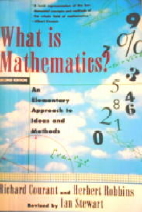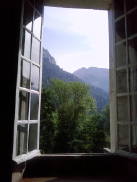Jason Padgett, author of the book Struck by Genius, appeared on CBS This Morning on April 24. On May 5, livescience also did a piece on him and his book. Padgett was assaulted in 2002 and suffered a severe concussion. But, following this head injury, he acquired an extraordinary facility for seeing mathematics. He is, as many say, an “acquired savant,” or prodigy in mathematics.
Padgett is quoted in the CBS article as saying:
I thought it was the pain medicine that they had given me that made me feel so strange….Things looked like individual picture frames coming in and clouds moving. Instead of looking smooth, they looked like little tangent lines in a spiral. Everything was discreet and chunky.
Padgett’s new skills are attributed, in part, to synesthesia, a condition where the senses blend – one might see music or hear color. From what I’ve read so far, it seems to be his visual experience that is most changed. But his visual experiences have motivated him to draw as well as do mathematics. In fact, for him, the mathematics appears to be contained in the drawings (which, in itself, is noteworthy).
Livescience author Tanya Lewis reports it this way:
With Padgett’s new vision came an astounding mathematical drawing ability. He started sketching circles made of overlapping triangles, which helped him understand the concept of pi, the ratio of a circle’s circumference to its diameter. There’s no such thing as a perfect circle, he said, which he knows because he can always see the edges of a polygon that approximates the circle.
According to the livescience article, functional magnetic resonance images of Padgett’s brain showed significant activation in the left parietal cortex, although it’s not clear in the article what Padgett is doing when the activation occurs. The parietal cortex is known to be an area where sensory information is integrated. I considered the relevance of the parietal cortex to mathematics in my +plus article as well as in a post from a few years ago.
In a 2005 article Edward Hubbard, Manuela Piazza, Philippe Pinel and Stanislas Dehaene write on the interactions between number and space in the parietal cortex. The authors conclude:
In the more distant future, it might become possible to study whether more advanced mathematical concepts that also relate numbers and space, such as Cartesian coordinates or the complex plane, rely on similar parietal brain circuitry. Our hypothesis is that those concepts, although they appear by cultural invention, were selected as useful mental tools because they fit well in the pre-existing architecture of our primate cerebral representations. In a nutshell, our brain organization both shapes and is shaped by the cultures in which we live.
But studies with Padgett went a bit further. In her article Lewis reports:
…the fMRI only showed what areas were active in Padgett’s brain. In order to show these particular areas were causing the man’s synesthesia, Brogaard’s team used transcranial magnetic stimulation (TMS), which involves zapping the brain with a magnetic pulse that activates or inhibits a specific region. When they zapped the parts of Padgett’s parietal cortex that had shown the greatest activity in the fMRI scans, it made his synesthesia fade or disappear, according to a study published in August 2013 in the journal Neurocase.
Berit Brogaard, who performed these studies, has shown in another study that “when neurons die, they release brain-signaling chemicals that can increase brain activity in surrounding areas.” The increased activity may not last, but if it produces structural changes, then the brain-activity changes would persist. Lewis doesn’t develop this idea but, for me, it calls to mind the kind of interaction ecologist Deborah Gordon described in her TED talk: What ants teach us about the brain, cancer and the internet. There Gordon describes how systems without a central control are directed by interaction. Ants operate within a network created by their interaction. For example, in situations where there may be a high cost to venturing out, the decision to forage for food can be a tricky one. Ants seem to add up the stimulation they receive from other ants to know whether they should begin. She compares the effectiveness of this interaction to neurons that add up the stimulation from other neurons to know whether to fire or not.
Author and psychiatrist Darold Treffert interviewed Padgett. Padgett writes:
…he told me that these innate skills are, in his words, “factory-installed software” or “genetic” memory. After interviewing me…..he also suggested that all of us have extraordinary skills just beneath the surface, much as birds innately know how to fly in a V-formation and fish know how to swim in a school.
While the experience of the savant is rare, and often coupled with disabilities of another kind, I think these mysterious talents provide a unique opportunity to explore the enigma of how we come to know anything. Perceiving very large quantities, in the absence of counting; having a sensory experience of numeric relationships; playing an instrument without ‘learning’ it, all these things happen. Treffert recounts some of his encounters in a very nice piece which appeared as a Scientific American Guest Blog last July. These remarkable abilities must be showing us something about the nature of the disciplines involved as well as the potential of brain functions.
In his book, Padgett says:
To me, a tree is more than its geometry, but geometry is also far more than most people realize. I think it’s everything.
And in the CBS report he says:
It means that we all have this ability within us,” he said. “I had no prior training whatsoever, and, like, we’re all doing complicated math and physics. … If somebody throws a ball and you catch it, you calculated the gravitational field, everything, and you caught that ball. Your brain- if you wrote that as an equation, that’s a serious equation to write, but you could just catch the ball automatically.


I just discovered you site, via jumping from “Physics Week in Review”. I want to subscribe to your site but keep getting a message “404: page not found”. I hope you will be able to correct this because I like what I’m seeing and would like to see more.
Thank you.
So glad you’re interested in what I’m doing here. I just tested my follow button and see that it is not working. I don’t know why, but I will try to correct it. Thanks again for visiting.